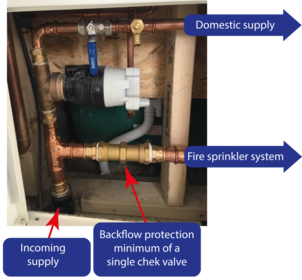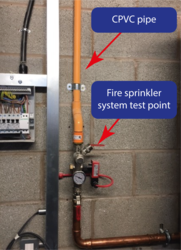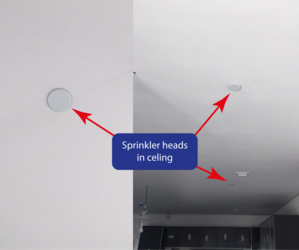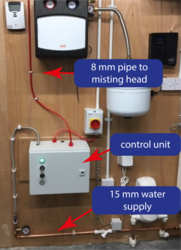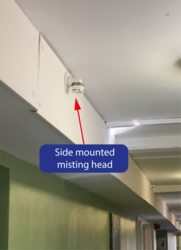Domestic and Residential Fire Suppression Systems
Amended July 2024
There has been a lot of focus on fire protection systems for single households since the Domestic Fire Safety Measure was passed by the Welsh Government and came in to force in 2016.
In Wales it has become compulsory to install an automatic fire suppression system in all new residences, which include houses and flats including those being converted as well as some specific types of buildings offering residential accommodation, such as:
care homes (as defined in the Regulation and Inspection of Social Care (Wales) Act 2016)
children’s residential homes
boarding houses
halls of residences
hostels
However there are some exceptions.
What has this to do with the water fittings regulations?
There are four main areas of Water Fittings Regulations which must be adhered to. Firstly, in most cases, proposed installations must be notified, to the local water company.
Secondly, there should be appropriate backflow protection at the point of supply to the fire suppression system. The water industry’s published interpretation on fire sprinkler systems provides information on factors which may influence the fluid categorisation and backflow protection requirements. These should be confirmed with the local water supplier before going ahead with an installation. In some systems there may be a need for additional backflow protection. For example, if the primary backflow protection is not located at the branch, but further downstream within the fire protection system, then the leg of pipework to the protection device will stagnate over time due to no water being drawn off. In these situations, a second backflow protection device is required at the branch to ensure stagnant water cannot be drawn back. Usually a single check valve is sufficient.
Thirdly, make sure you select products that have been tested to a suitable quality and standard. For fire suppression systems these tests include checks that products don’t leak. British Insurers data shows that during a spell of freezing weather, a claim to repair a burst pipe costs an average of £8,800 – and can often be more.
Finally, systems must be installed in a workman like manner. The easiest way to demonstrate that work is undertaken in a workman like manner, would be to comply with the appropriate British Standard. Traditionally for domestic and residential fire systems there has been only one standard suitable, BS 9251, which only covers sprinkler systems. However, a European standard has recently been published for buildings up to four stories up to 18 m in height, work is ongoing to cover buildings above four stories. More recently a standard for misting systems has been developed. The current appropriate standards are:
BS 9251 – ‘Fire Sprinkler systems for residential and domestic occupancies - Code of practice’. (visit BSI shop)
BS EN 16925:2018 - Fixed firefighting systems. Automatic residential sprinkler systems. Design, installation and maintenance. (visit BSI shop)
BS 8458 ‘Residential and domestic watermist systems - Code of practice for design and installation’ (visit BSI shop)
A key requirement to meeting any of these standards is to make sure there is sufficient availability of water. The water demand will depend on a number of factors from the room layout in the property, system design and the fire system fittings to be used. This means there can be great variability in flow requirements. Typically, designers will try and utilise the flow and pressure of the public mains supply wherever possible. This not only simplifies the design, but reduces the overall space requirements of the system. Where there is insufficient water pressure or flow this can be overcome by installing storage cistern and pump, or in some cases a booster pump on the incoming mains supply may be permitted. However, you will need the permission of the local water company before installing it.
The fire system must be readily identifiable from other water systems in the building. This is to help avoid inadvertent miss connections to it. Usually this is usually achieved by labelling the system to British Standard BS 1710 (2014). WRAS (now Water Regs UK) has published a handy ‘Pipe identification information note’ (click to view) which covers what this might look like and can be found in the publications section of the website.
Example of pipe marking fire protection system supplied from the public supply

What do these difference systems look like?
Sprinkler installations (BS EN 16925 & BS 9251)
Traditional systems use water to dampen and ultimately extinguish a fire. This means using a sprinkler head to spread water droplets over a particular area. The flow rate requirements can be up to 80 litres per minute or more if two heads are activated. If this is not achievable direct from the mains an alternative water storage cistern would be required. In these situations, pumped storage of 1,000 litres would not be uncommon.
For a direct mains-fed system the water supply to the property is usually provided by a single larger than normal service pipe (typically minimum 32 mm), although some water companies may provide separate pipes from their mains.
Once pipework enters the premises there are two main types of configurations, the first splits on the customers side of the property boundary to supply the fire sprinkler system and the domestic water supply. The second type takes the service pipe direct in to the building before the supply splits. At the point of separation is usually a ‘tee’ with a single check valve installed on the leg for the fire sprinkler system to protect the domestic supply from stagnation. Where the split is external to the building, then the check valve should be installed in a chamber, so that it can be maintained.
On the domestic side of the ‘tee’ a stop valve, meter (depending upon individual water company metering policy) and drain valve is installed as you would normally expect.
Fire sprinkler system control and test point
The control valve and test point is installed at the most convenient point, with the supply to it. It is usually installed by the plumbing contractor. The fire system valve set and pipework is then installed by the Fire Sprinkler contractor. It is recommended that the system is designed and installed by a contractor who is certified by a UKAS approved fire sprinkler certification body, of which there are currently three in the UK. As a minimum, the IQ Level 2 Certificate in Fire Sprinkler Installation covering all building types, for those installing in DOMESTIC properties (e.g. houses and bungalows) the installer should have achieved the 'level 3' up-skilling award for:
Design of Automatic Fire Sprinkler Systems for Residential and Domestic Dwellings; and
Installation and Maintenance of Automatic Fire Sprinkler Systems in Domestic Dwellings
The awarding body for these 'up-skilling awards' is Agored, a Welsh awarding body. There are two colleges in Wales who offer training for these awards and The Manchester College is about to also offer them.
Sprinkler heads
One common myth about fire sprinkler systems is that all of the sprinkler heads will discharge water when the system is activated. In fact, they are heat activated so only the heads closest to the fire will be triggered. The number of sprinkler heads installed in a room will depend upon the size or shape of the room, but for a small room (approximately 5 m x 5 m) only one head is normally required. In domestic applications the sprinkler head often comes with a protective cover (see image) which must not be painted or in any other way covered. On activation the cover will come away exposing the sprinkler head which will then dispense the water.
Since Grenfell Tower tragedy there has been an exponential rise in the number of housing providers and building owners who want to install sprinklers in their properties - both new and existing buildings.
Ian Gough BAFSA (British Automatic Fire Sprinkler Association)
Watermist systems (BS 8458)
Rather than dispensing large amounts of water watermist systems, as its name suggests, provide a fine water mist usually 50-150 micron sized water droplets. To put that in context, did you know the human hair is about 75 microns in size! Rather than extinguishing the fire the small droplet size of a misting system aims to reduce the heat and smoke and limit the probability of flashover and the fire spreading. This gives the occupants the opportunity to evacuate the building.
The flow rates required for a misting system are considerably lower than needed for traditional sprinkler heads, and so smaller pipework can be used. These systems operate at a much higher pressures, up to 65 bar. Therefore, these systems cannot rely on mains water pressure alone and need a specially designed pump-set and control system.
Water mist heads are different to sprinkler heads and will either come as a series of directional nozzles or as a flat faced head which can be recessed in to the celling giving a flush mounted appearance. Like the sprinkler, misting heads and nozzles must not be painted or covered in any way. Just as with fire sprinkler systems, these should be designed and installed by an appropriate competent person.
Water mist systems for domestic situations are relatively new and there are fewer bespoke systems in the market. So if you are considering installing or getting these types of system make sure it has been tested and proved to conform to BS 8458.
Top tips – How to avoid potential problems installing a fire suppression systemFire suppression systems have an important role to play in protecting lives and property. If you are installing fire system make sure you comply with the water fittings regulations by:
|

